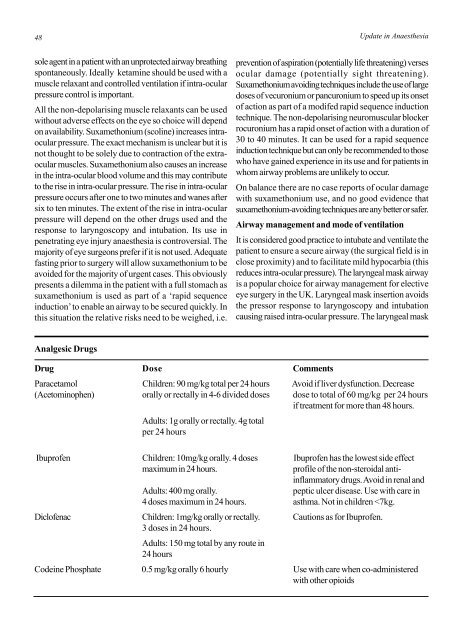Download Update 11 - Update in Anaesthesia - WFSA
Download Update 11 - Update in Anaesthesia - WFSA
Download Update 11 - Update in Anaesthesia - WFSA
Create successful ePaper yourself
Turn your PDF publications into a flip-book with our unique Google optimized e-Paper software.
48<strong>Update</strong> <strong>in</strong> <strong>Anaesthesia</strong>sole agent <strong>in</strong> a patient with an unprotected airway breath<strong>in</strong>gspontaneously. Ideally ketam<strong>in</strong>e should be used with amuscle relaxant and controlled ventilation if <strong>in</strong>tra-ocularpressure control is important.All the non-depolaris<strong>in</strong>g muscle relaxants can be usedwithout adverse effects on the eye so choice will dependon availability. Suxamethonium (scol<strong>in</strong>e) <strong>in</strong>creases <strong>in</strong>traocularpressure. The exact mechanism is unclear but it isnot thought to be solely due to contraction of the extraocularmuscles. Suxamethonium also causes an <strong>in</strong>crease<strong>in</strong> the <strong>in</strong>tra-ocular blood volume and this may contributeto the rise <strong>in</strong> <strong>in</strong>tra-ocular pressure. The rise <strong>in</strong> <strong>in</strong>tra-ocularpressure occurs after one to two m<strong>in</strong>utes and wanes aftersix to ten m<strong>in</strong>utes. The extent of the rise <strong>in</strong> <strong>in</strong>tra-ocularpressure will depend on the other drugs used and theresponse to laryngoscopy and <strong>in</strong>tubation. Its use <strong>in</strong>penetrat<strong>in</strong>g eye <strong>in</strong>jury anaesthesia is controversial. Themajority of eye surgeons prefer if it is not used. Adequatefast<strong>in</strong>g prior to surgery will allow suxamethonium to beavoided for the majority of urgent cases. This obviouslypresents a dilemma <strong>in</strong> the patient with a full stomach assuxamethonium is used as part of a ‘rapid sequence<strong>in</strong>duction’ to enable an airway to be secured quickly. Inthis situation the relative risks need to be weighed, i.e.prevention of aspiration (potentially life threaten<strong>in</strong>g) versesocular damage (potentially sight threaten<strong>in</strong>g).Suxamethonium avoid<strong>in</strong>g techniques <strong>in</strong>clude the use of largedoses of vecuronium or pancuronium to speed up its onsetof action as part of a modifed rapid sequence <strong>in</strong>ductiontechnique. The non-depolaris<strong>in</strong>g neuromuscular blockerrocuronium has a rapid onset of action with a duration of30 to 40 m<strong>in</strong>utes. It can be used for a rapid sequence<strong>in</strong>duction technique but can only be recommended to thosewho have ga<strong>in</strong>ed experience <strong>in</strong> its use and for patients <strong>in</strong>whom airway problems are unlikely to occur.On balance there are no case reports of ocular damagewith suxamethonium use, and no good evidence thatsuxamethonium-avoid<strong>in</strong>g techniques are any better or safer.Airway management and mode of ventilationIt is considered good practice to <strong>in</strong>tubate and ventilate thepatient to ensure a secure airway (the surgical field is <strong>in</strong>close proximity) and to facilitate mild hypocarbia (thisreduces <strong>in</strong>tra-ocular pressure). The laryngeal mask airwayis a popular choice for airway management for electiveeye surgery <strong>in</strong> the UK. Laryngeal mask <strong>in</strong>sertion avoidsthe pressor response to laryngoscopy and <strong>in</strong>tubationcaus<strong>in</strong>g raised <strong>in</strong>tra-ocular pressure. The laryngeal maskAnalgesic DrugsDrug Dose CommentsParacetamol Children: 90 mg/kg total per 24 hours Avoid if liver dysfunction. Decrease(Acetom<strong>in</strong>ophen) orally or rectally <strong>in</strong> 4-6 divided doses dose to total of 60 mg/kg per 24 hoursif treatment for more than 48 hours.Adults: 1g orally or rectally. 4g totalper 24 hoursIbuprofen Children: 10mg/kg orally. 4 doses Ibuprofen has the lowest side effectmaximum <strong>in</strong> 24 hours.profile of the non-steroidal anti<strong>in</strong>flammatorydrugs. Avoid <strong>in</strong> renal andAdults: 400 mg orally.peptic ulcer disease. Use with care <strong>in</strong>4 doses maximum <strong>in</strong> 24 hours. asthma. Not <strong>in</strong> children
















